Foraging wild herbs throughout the seasons releases delightful flavors and health benefits for your unique tea blends. In spring, gather dandelion greens and stinging nettle for richness and earthy taste. Summer brings invigorating mint and calming lemon balm. As autumn arrives, infuse your teas with aromatic sage and thyme for warmth. Winter's hardy herbs, like pine and wintergreen, add rejuvenating elements. Always practice responsible harvesting and proper identification to guarantee safety. By exploring seasonal highlights and preparation tips, you'll enhance your foraging experience and create delicious herbal concoctions. There's so much more to discover on this herbal adventure!
Spring Foraging Opportunities

As the chill of winter fades, spring reveals a bounty of wild herbs perfect for foraging. You'll find that this season offers an array of vibrant greens just waiting to be discovered.
Start your adventure by looking for dandelion greens, which are rich in vitamins and have a slightly bitter flavor. They make a fantastic addition to any herbal tea blend.
Another great option is stinging nettle, known for its nutritional benefits. Just remember to wear gloves while handling it! Once you've cooked or dried the leaves, you can enjoy their earthy taste in your teas.
Wild garlic is also abundant in spring; its mild flavor can elevate your herbal concoctions.
Don't forget about clover flowers, which add a sweet note to your blends. As you explore your local area, keep an eye out for other wild herbs like chickweed and plantain, both of which can enhance your tea experience.
Foraging not only connects you with nature but also provides unique flavors for your blends. Make certain to bring a guidebook or app on your foraging trips to identify the plants accurately and guarantee you're harvesting safely.
Happy foraging!
Summer Herb Harvesting
While the sun shines brightly and temperatures rise, summer presents a perfect opportunity for herb harvesting. It's the time when many herbs reach their peak flavor and liveliness. As you venture out, keep an eye out for vibrant plants that thrive in warmer weather.
Here's a quick reference guide to some popular summer herbs you can forage:
| Herb | Best Time to Harvest | Uses in Tea Blends |
|---|---|---|
| Mint | Late morning | Invigorating, cooling teas |
| Lemon Balm | Early afternoon | Calming, lemony flavor |
| Chamomile | Early morning | Soothing, floral notes |
| Basil | Midday | Sweet, aromatic blends |
When foraging, always verify you're in a clean area, away from pollutants. Harvest responsibly by taking only what you need and leaving enough for the plant to flourish. After gathering, wash the herbs thoroughly to remove any dirt or insects. You can dry them for later use or brew them fresh for a delightful summer tea. Enjoy the vibrant flavors of your harvest!
Autumn's Bounty of Herbs

Autumn brings a vibrant array of herbs that are perfect for foraging, with many reaching their peak flavor just before the first frost. This is the ideal time to gather herbs like sage, thyme, and rosemary, which thrive in cooler weather. Their robust flavors add depth to your tea blends, making them warming and comforting as the days grow shorter.
As you explore your surroundings, keep an eye out for wild mint varieties, such as spearmint and peppermint. These herbs can provide a revitalizing twist to your autumn teas.
Don't forget about chamomile, which often blooms into late autumn. Its sweet, apple-like flavor is perfect for soothing evening brews.
Remember to forage responsibly; only take what you need and guarantee you're not depleting local populations. Look for healthy, vibrant plants, avoiding those that show signs of disease or damage. Always double-check your identification, as some herbs have look-alikes that can be toxic.
With a little patience and practice, you can create delightful tea blends that capture the essence of autumn. Embrace the season's bounty and enjoy the flavors that nature has to offer.
Happy foraging!
Winter Foraging Tips
As winter sets in, foraging for herbs can be a rewarding experience if you know where to look.
You'll discover the best winter herbs while keeping safety in mind, ensuring you're well-prepared for your foraging adventures.
Plus, learning how to properly store and prepare these herbs will help you enjoy your bounty all season long.
Best Winter Herbs
Winter foraging may seem intimidating, but a treasure trove of herbs awaits those willing to brave the cold. While many plants lie dormant, a few hardy herbs thrive, ready to enhance your winter tea blends.
One of the best winter herbs is pine. Gather fresh needles for a revitalizing, vitamin C-rich infusion. You can also try foraging for wintergreen, which offers a minty flavor and soothing properties. Just be sure to recognize it by its glossy leaves and pleasant scent.
Another excellent choice is chamomile, often still available in milder climates. Its dried flowers make a calming tea, perfect for cozying up on chilly nights.
You might also find some resilient sage and thyme, which can add depth and warmth to your blends.
Lastly, consider foraging for dried rose hips. These bright red fruits of the rose plant are packed with antioxidants and make a deliciously tangy addition to your tea.
With a little patience and exploration, you'll discover that winter is far from barren—it's a season ripe for herbal adventures. So bundle up, grab your foraging basket, and enjoy the bounty of winter herbs waiting for you.
Foraging Safety Tips
When foraging in winter, it's important to prioritize safety to guarantee a rewarding experience. The colder months can present unique challenges, so keep these tips in mind.
- Dress Appropriately: Wear layers to stay warm and dry. Waterproof boots are vital for traversing snowy or wet terrain.
- Know Your Plants: Familiarize yourself with winter herbs and their look-alikes. Some plants can be toxic, especially when dormant.
- Scout Locations: Stick to familiar areas where you know the landscape and plant life. Avoid foraging in places exposed to heavy traffic or pollution.
- Bring a Friend: Foraging with a buddy not only enhances safety but also provides a second opinion on plant identification.
- Stay Aware of Weather: Check forecasts before heading out. Sudden weather changes can turn a safe outing into a risky venture.
| Tip | Description | Importance |
|---|---|---|
| Dress Appropriately | Layer up and wear waterproof boots. | Keeps you warm and dry. |
| Know Your Plants | Identify edible versus toxic herbs. | Prevents harmful mistakes. |
| Scout Locations | Forage in familiar, safe areas. | Reduces risk of hazards. |
| Bring a Friend | Have a companion for safety. | Increases safety and fun. |
| Stay Aware of Weather | Monitor weather before foraging. | Guarantees a safe experience. |
Preparation and Storage
Proper preparation and storage of your foraged herbs can greatly enhance your tea blends. To guarantee your herbs stay fresh and flavorful throughout the winter, follow these essential steps:
1. Clean Thoroughly: Rinse your herbs gently under cold water to remove dirt and insects. Pat them dry with a clean towel.
2. Dry Properly: Hang your herbs in small bundles in a cool, dark, and well-ventilated area. Alternatively, you can use a dehydrator or an oven set to low heat.
Make certain they're completely dry before storing.
3. Store in Airtight Containers: Once dried, place your herbs in glass jars or vacuum-sealed bags. This helps preserve their flavor and aroma.
Label the containers with the herb name and date of storage.
4. Keep in a Cool, Dark Place: Store your herbs in a pantry or cupboard away from direct sunlight and moisture.
This guarantees they maintain their potency throughout the winter months.
Seasonal Herb Characteristics
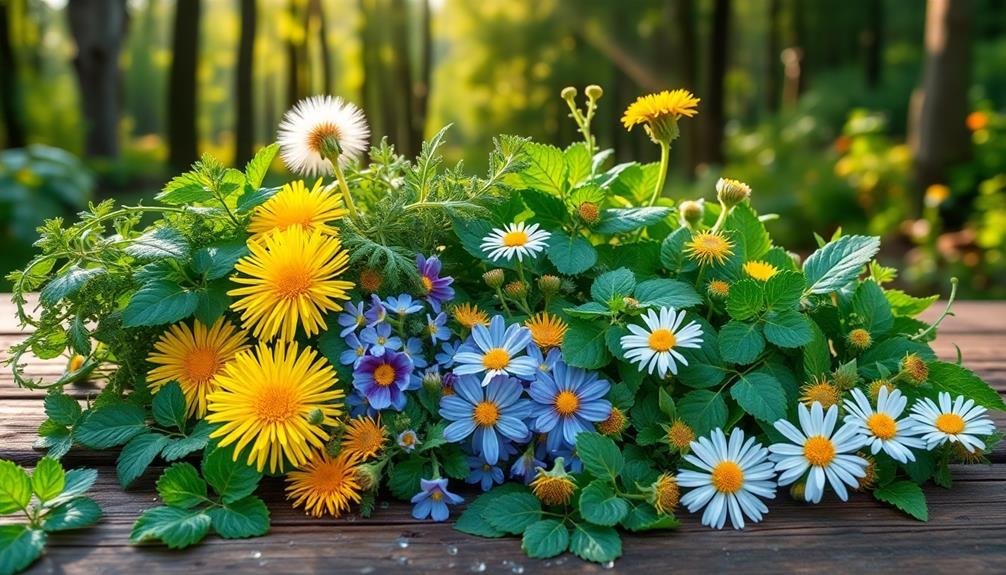
Seasonal changes dramatically influence the characteristics of wild herbs, shaping their flavors, aromas, and medicinal properties.
In spring, you'll find herbs like nettle and dandelion bursting with fresh energy. Their tender leaves are packed with nutrients, making them ideal for invigorating teas that can boost energy levels.
As summer rolls in, herbs like lemon balm and peppermint reach their peak potency. Their strong scents and flavors make revitalizing summer brews that cool you down and uplift your spirits.
When autumn approaches, you'll notice a shift. Herbs like sage and thyme become more aromatic, offering earthy flavors perfect for warming teas. Their properties can support digestion and provide comfort as the weather cools.
In winter, hardy herbs such as rosemary and certain conifers retain their strength. Their robust flavors can be extracted in hot infusions, providing warmth and immune support during the colder months.
Best Practices for Foraging
When foraging for wild herbs, knowing your local flora is essential for both safety and successful harvesting.
You'll want to practice sustainable techniques to protect the environment while ensuring a good yield.
Familiarizing yourself with safety tips and proper identification methods can help you enjoy the process without any worry.
Know Your Local Flora
Understanding your local flora is essential for successful foraging, as it not only enhances your tea blends but also guarantees your safety. Familiarizing yourself with the plants in your area will help you identify edible herbs while avoiding harmful ones.
Here are some best practices to get you started:
- Research Local Species: Look up wild herbs native to your region. Field guides or apps can be great resources for identifying plants and their uses.
- Join a Foraging Group: Connect with local foragers or join workshops. Learning from experienced foragers can accelerate your knowledge and build your confidence.
- Observe Seasonal Changes: Different herbs flourish at various times of the year. Keep a seasonal calendar to track when certain plants are at their peak.
- Take Notes and Photos: Document your foraging trips. Photos can help with identification later, and notes on where you found specific herbs will refine your foraging skills over time.
Sustainable Harvesting Techniques
To guarantee you're foraging responsibly, it's crucial to adopt sustainable harvesting techniques. Start by only taking what you need. A good rule of thumb is to harvest no more than one-third of a plant's leaves or flowers. This guarantees the plant can continue to thrive and reproduce.
Be mindful of the environment around you. Avoid trampling nearby plants and disturbing wildlife habitats. If you're foraging in a public area, stick to established trails to minimize your impact.
Use clean tools when cutting herbs, and always clean up after yourself. This includes packing out any trash you bring with you and leaving the area as you found it.
Consider the seasons, too. Some plants need time to recover after harvesting, so give them a break by timing your foraging trips wisely. For instance, early spring is a great time for young greens, while summer herbs flourish in full bloom.
Lastly, familiarize yourself with local regulations. Some areas have restrictions on foraging to protect native species. By following these sustainable harvesting techniques, you'll help guarantee that wild herbs remain abundant for future foragers.
Safety and Identification Tips
After mastering sustainable harvesting techniques, it's time to focus on safety and proper identification while foraging. Knowing how to recognize edible plants and avoid toxic look-alikes is essential for a successful and safe foraging experience. Here are some best practices to keep in mind:
- Use a Field Guide: Invest in a reliable field guide that includes photos and descriptions of local edible plants. This will help you identify herbs accurately.
- Learn from Experts: Consider joining a local foraging group or attending workshops with experienced foragers. They can share invaluable tips and insights.
- Inspect Carefully: Before harvesting, examine each plant closely. Look for unique characteristics like leaf shape, flower color, and growth patterns to confirm your identification.
- Trust Your Instincts: If you're unsure about a plant's edibility, don't take the risk. Always err on the side of caution and choose safety over curiosity.
Preparing Your Tea Blends

When you're ready to prepare your tea blends, the first step is to gather your foraged herbs and ascertain they're clean and dry. Rinse them under cold water to remove any dirt or insects, then lay them out on a clean kitchen towel or a drying rack. Allow them to air dry completely.
Next, decide on your blend's flavor profile. Think about the combination of earthy, floral, and herbal notes you want to achieve. For a balanced blend, use about one part of stronger flavors (like mint or sage) to two parts of milder herbs (like chamomile or lemon balm).
Once you've chosen your herbs, chop or crush them lightly. This helps release their essential oils and enhances the flavor. Measure out the desired amounts, combining them in a bowl.
Store your blend in an airtight container, away from light and moisture. When you're ready to brew, use one tablespoon of your herbal blend per cup of hot water. Steep for about five to ten minutes, taste-testing along the way. Enjoy your unique creation, knowing it's made with your own foraged herbs!
Frequently Asked Questions
What Are the Most Common Edible Wild Herbs to Look For?
When foraging for wild herbs, look for common ones like dandelion, nettle, and chickweed. These herbs are nutritious, flavorful, and easy to identify. Just make sure you're foraging in safe, pesticide-free areas.
How Do I Identify Medicinal Properties in Foraged Herbs?
To identify medicinal properties in foraged herbs, research their traditional uses, observe their physical characteristics, and consult reliable sources. You can also seek guidance from experienced foragers to enhance your understanding and confidence in herbal identification.
Are There Any Poisonous Herbs to Avoid While Foraging?
Absolutely, there are poisonous herbs to avoid while foraging. You should familiarize yourself with common toxic plants like hemlock and foxglove. Always double-check your identification and consult reliable resources before consuming any foraged herbs.
Can I Forage Herbs in Urban Areas?
You can definitely forage herbs in urban areas! Just be mindful of potential contaminants, like pollution and pesticides. Research local regulations and identify safe spots, ensuring you're gathering from clean, non-treated environments for your foraging adventures.
What Tools Do I Need for Successful Wild Herb Foraging?
You'll need some essential tools for successful wild herb foraging. A sharp knife, sturdy basket, gloves, and a field guide are key. Don't forget to wear comfortable shoes and bring water to stay hydrated!
In Summary
As you embrace the seasons and explore the world of wild herb foraging, remember to savor each moment and connection with nature. By gathering fresh herbs throughout the year, you'll create unique, flavorful tea blends that reflect the essence of each season. Stay mindful of sustainable practices, and let your creativity flourish as you experiment with different combinations. So grab your basket, head outdoors, and enjoy the rewarding adventure of foraging for your next perfect cup of tea!

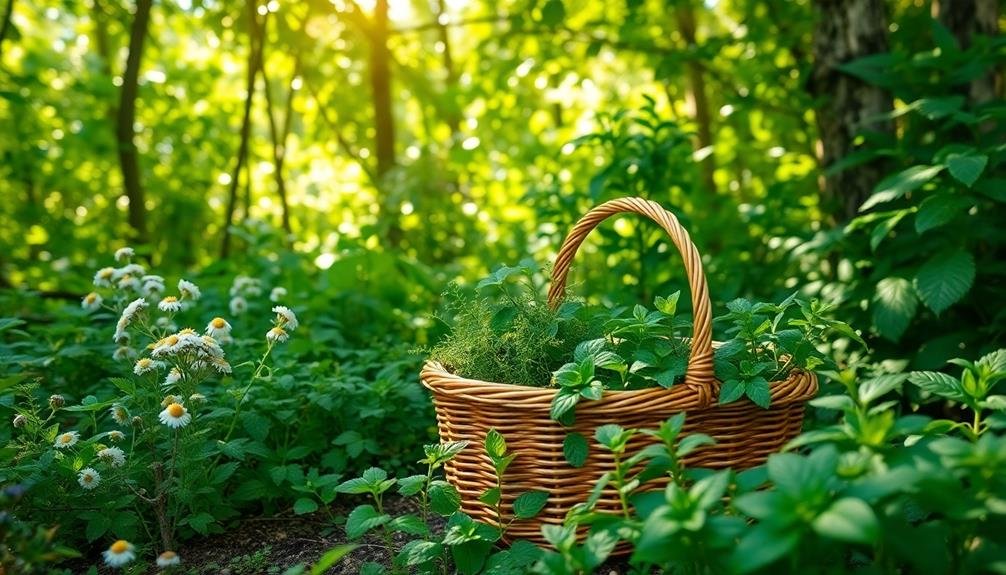
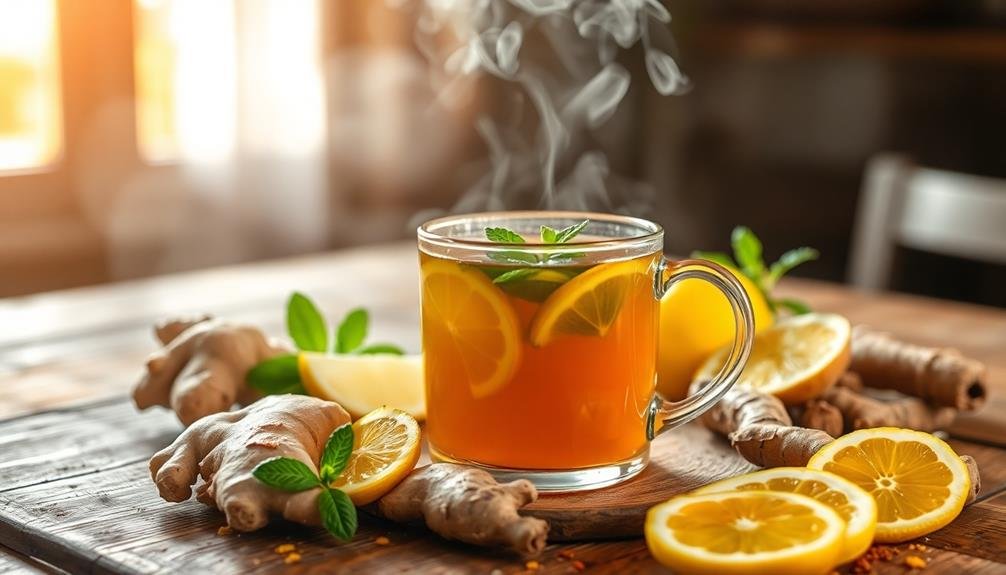
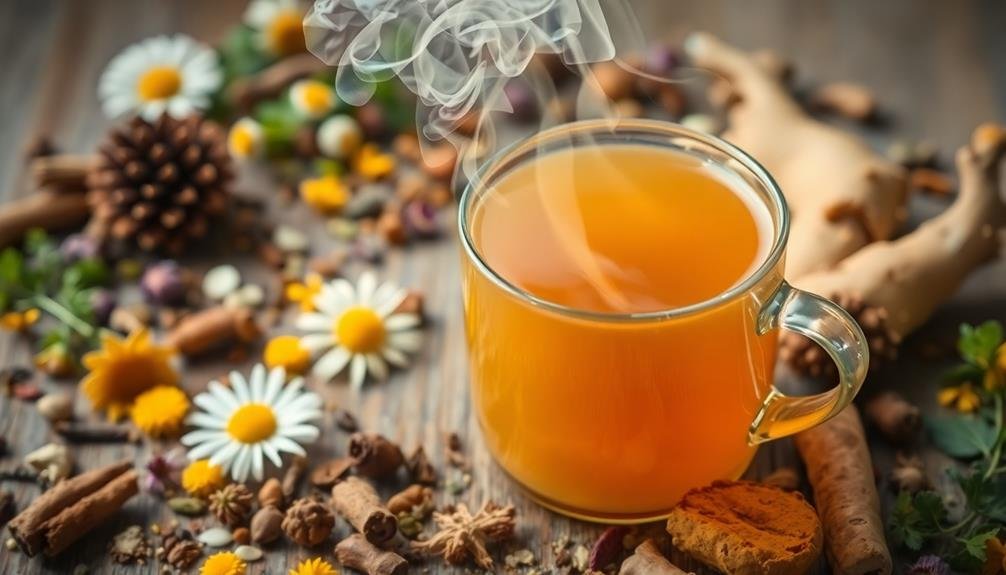
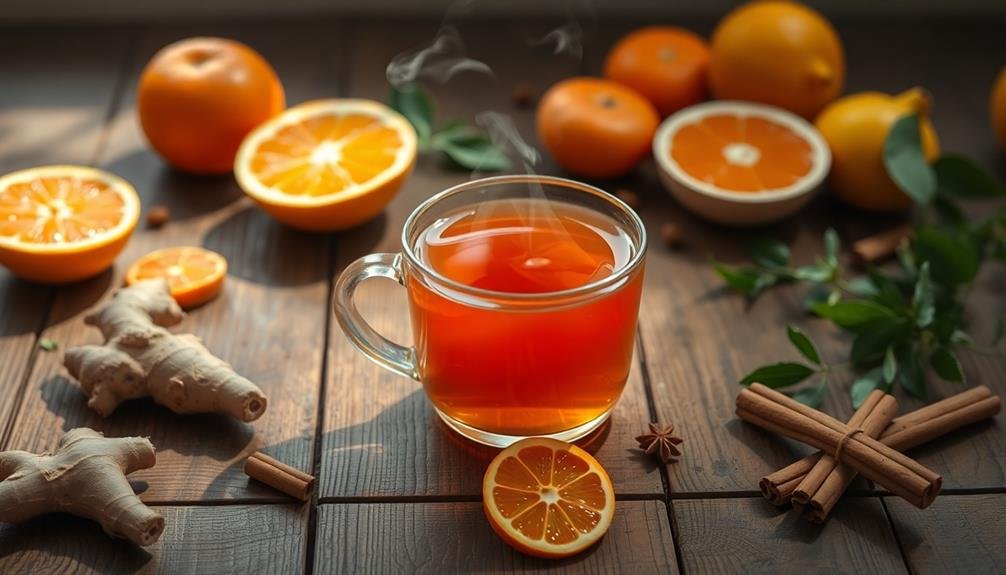
Leave a Reply